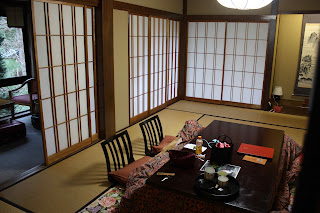Although this is another late blog post (I have excuses! I
do!), you might not be able to tell simply by looking at the photos––snow in
mid-February looks just like snow in early January. I’m tired of all this snow!
In any case, this post covers a trip I made to Bessho Onsen in Nagano, Japan,
at the beginning of 2013, directly following oshogatsu, which is the Japanese New Year.
I had spent Christmas with
my family in Santa Barbara, California, which by all accounts is a nice,
warmish place to spend a winter holiday. Rather than spend New Year’s there, however, I seemed to confuse my family by scheduling my return to snowy Japan a day
or two early. Maybe this blog will clear up that confusion––something
special awaited me back in Japan: a nice stay at a traditional hot spring inn.
The entrance to the Risenro Kashiwaya hot spring inn.
Moss covered stone frogs near the entrance to the inn, ready to grant your wishes for just a smattering of your pocket change.
Upon entering and checking in one is served dried and sweetened local persimmons with green tea and a small serving of black jelly.
It's incredible how simple a room at a Japanese inn looks, and yet there's something very luxurious and warm about it.
From the sitting room one could see snow-dusted pines and a small garden below.
But what it’s even more famous for are the architectural features of the temple’s wooden pagoda. Its octagonal shape is replicated nowhere else in Japan, and the pagoda is considered a national treasure.
If you look closely you can see the snowmelt running off the eaves and being blown by the wind.
The temple design, which employs no metal, is incredibly complex and sophisticated.
Anrakuji Temple is open from 9 a.m. to 4 or 5 p.m. every day—depending on the season—and costs ¥300 to enter. http://www.anrakuji.com
Nearby are many other temples and shrines, as well as traditional hot spring inns, restaurants, street vendors, and souvenir shops. English on the signs makes it easy to get around for those who don’t understand Japanese.
Jorakuji Temple is another well known area destination. The most striking features of this 13th-centry temple are a thatched roof, a rare stone pagoda, and a small museum inside that houses small wooden prayer boards painted by Hokusai (1760-1849), one of Japan’s most famous painters and woodcut artists.
Walking around one finds other attractions, large and small. Below are rows of old tombstones, covered in snow and moss
Also, from almost any of the area’s temples one gets fantastic views of the valley and mountains.
Surprisingly, well off the main road and tucked into the mountainside was a handmade soba shop. Apparently it’s in a lot of guidebooks, because there was a wait to get in.
Once in, however, there’s a nice selection of soba (buckweat noodles) and other locally sourced menu items. I went with a tempura udon set, which came with pickled veggies (takuan) and hot green tea.
One of the soba-ya’s specialties was soba dumplings, served with two types of miso paste. Definitely a good way to warm up after spending time in the wintry outdoors.
After lunch it was time to check in (finally), and I immediately changed into my inn-issued bathrobe and headed to the hot spring. As you can see below, one of the baths was indoors and one was outdoors. The one outdoors was full of a white substance floating in the water so that I felt a little like I was sitting in egg-drop soup. It was a bit strange to me, but supposedly those floaty bits add to the mineral content of the spring water and are healthful. The inn also offers a private hot spring bath for ¥3000 for 45 minutes, which is a nice alternative for couples and families that would prefer to enjoy the hot springs together rather than in gender-separate facilities.
I came out here once at night, too, and had the entire bath to myself as snow was falling.
Like any traditional inn in Japan, full-course meals are available and are often done in a kaiseki or kaiseki-ryouri style. Sometimes inns will serve you course-by-course in your room, but many inns have separate dining rooms in which guests eat. Normally one gets dinner and breakfast, but it’s not cheap.
The inn served a variety of fresh seafood (though it’s located in the mountains) as well as mountain vegetables. As you can see, presentation is as important as the quality and freshness of the food. I actually wasn’t able to finish my meal, though I made it to the final course and the rice served at the end. Somehow, though, I found room at the end for dessert.
Normally a temple’s Kannon statue is said to hear prayers made for the next life, but this one is reputed to answer them for this life. It was easily the most crowded temple in Bessho Onsen, but that might have been due to the fact that it was the New Year.
This ryokan was one of the nicest ones I’ve stayed in, and I loved the fact that it was famous for accommodating so many famous Japanese writers last century. While there’s not so much to do in Bessho Onsen, you really can’t beat this place for relaxation. In the warmer months, too, it must be incredibly pleasant to stroll around in the evenings. One feels closer to "old Japan" in places like this, which makes the trip and the cost of staying here worth it.
Risenro Kashiwaya Ryokan offers various stay plans and the cost depends on various factors such as the size of your room, the number of guests, the types of amenities you want, and whether or not you will order the kaiseki ryouri cuisine. For more on this inn, please check the following website: http://www.rinsenro.com/













































